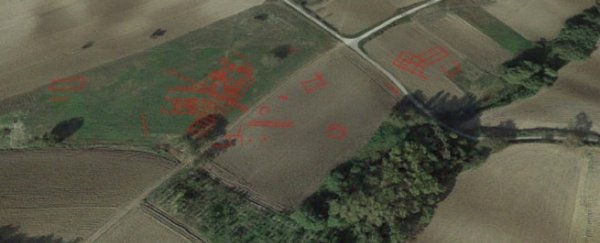For the first time, drone-flying archaeologists have been able to scan the ruins of an ancient settlement hidden below the Apennine Mountains of Italy, giving us important insight into this mysterious religious site.
The ruins were first discovered a few years ago, when construction workers unearthed two ancient temples in the region, dating back to the late Roman period, around 300 to 600 AD, when the Tappino Valley region was known as Samnium.
Limited excavation has been done on the temples since then, and very little is known about what they were used for or even who was using them. Across central Italy, there are several of these ritual sites that still remain a mystery to archaeologists.
One of the main hurdles to understanding more about these cult settings is the rough terrain of the Apennine Mountains, which makes it very difficult for archaeologists to conduct aerial surveys of potential structures surrounding the ritual sites.
As the researchers explain, it's dangerous and expensive to fly a normal plane over the hilly terrain at low-enough altitudes and speeds that would allow the team to gather any sort of reliable data.
"There was no good knowledge about other sites, such as villages, farms, villas, graveyards and so on, that could tell us more about the ancient inhabitants in the area that visited the cult sites," team leader Tesse Stek, from Leiden University in the Netherlands, told Charles Q. Choi at Live Science.
"They seemed to be cathedrals in the desert, so to say."
Using drones to take photos of the area between 2013 and 2015, the Dutch team was finally able to get a clear image of the area from the sky – and after using computer programs to image what might lie below the surface, they've now shown that the area is densely packed with potential settlements at a rate that they never expected.
"I could not believe it at first, but as they showed up on the computer screen at our base camp, the whole team started to yell, 'Wow!'" Stek told Live Science.
"We have a very complete overview of the internal organisation of the settlement, including its disposition along the road, storage spaces, domestic areas, and so on."
These new structures will need to be excavated before we can know more about what they were used for, and how they relate to the temples, but it's exciting progress that serves as a reminder for just how important drones are as a tool for archaeologists.
Until actual excavation happens, many mysteries will still surround the possible settlements – but at least we now know where to look, so we can begin to understand more about the people that lived there, and why they abandoned their homes.
The team's findings were published in the Journal of Cultural Heritage.
